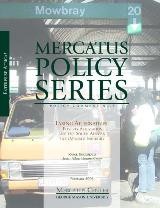- | Policy Briefs Policy Briefs
- |
Taxing Alternatives: Poverty Alleviation and the South African Taxi Minibus Industry
In order for policies that address taxi violence to be as effective as possible, they must focus on official corruption and establishing mechanisms that determine the access to taxi routes and ranks.

After five decades and billions of dollars, foreign aid to Africa has failed to ignite sustainable economic growth and poverty alleviation. For too many Africans, their quality of life today is worse than it was thirty years ago.
Rather than looking to outsiders for answers, the key to poverty alleviation in Africa is more likely to come from local entrepreneurship. However, this is often thwarted by government actions that make it difficult, if not impossible, to start and grow a business.
The taxi/minibus industry in South Africa serves approximately 65% of the South Africans using public transportation and has been a wellspring of black entrepreneurial activity. Yet, this industry suffers from a legacy of illegality—thanks to apartheid-era laws that restricted economic opportunities for black South Africans. It also suffers from continuing problems of violence and from safety concerns.
In order to address these problems, the South African government created the Taxi Recapitalization Programme (TRP). The TRP requires taxi/minibus operators to trade in 16-seat minibuses and purchase larger, new vehicles. However, this policy will not address the underlying problems that continue to provoke taxi violence.
In order for policies that address taxi violence to be as effective as possible, they must focus on official corruption and establishing mechanisms that determine the access to taxi routes and ranks. This can be achieved by creating secure, defendable, and tradable property rights over routes and rank.
Citation (Chicago Style):
Boudreaux, Karol. "Taxing Alternatives: Poverty Alleviation and the South African Taxi/Minibus Industry." Mercatus Policy Series Policy Comment No. 3. Arlington, VA. Mercatus Center at George Mason University. March 2006.

